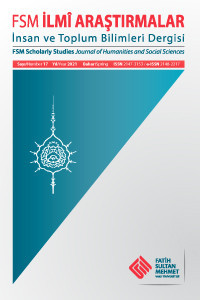Mehmed Âkif’in Fatih Kürsüsünde ve Âsım’da Hadis Atıfları
Safahat’ta Mehmed Âkif’in Kur’an âyetleri, hadisler ve sahâbe uygulamaları ışığında
bireysel ve toplumsal problemlere çözüm yolları aradığı bilinen bir husustur. “Mehmed
Âkif’in Fatih Kürsüsünde ve Âsım’da Hadis Atıfları” konulu bu makalede, “İslâm
şâiri”nin atıfta bulunduğu hadislerin kaynakları tesbit edilerek açıklamaları yapılmıştır.
Ele alınan toplam sekiz hadis atıfı, Mehmed Âkif’in Kur’an, hadis ve sünnet bilgisi yanında
sahâbe hayatına vukufunun ipuçlarını vermektedir. Onun, Rasûl-i Ekrem’e nisbeti
asılsız (mevzu) olan haberler karşısında prensip olarak titiz ve münfail olduğu görülmektedir.
Ne var ki bazen onun, sübut ve sıhhat derecesini araştırmadan hadisleri kullandığı
da vâriddir. Ancak bu durum, gözden kaçan ve kasıtsız mevzu diye nitelenen bir tasarruf
olarak değerlendirilmelidir.
Anahtar Kelimeler:
Mehmed Âkif; Safahat; Fatih Kürsüsü; Âsım; Hadis
References to Hadiths in Mehmed Akif’s Poems “At the Fatih Pulpit” and “Asım”Abstract
As it is a widely known reality that in his poetic work Safahat, Mehmed Akif searches
for solutions to social problems by means of Kuranic verses, hadiths and actions
the people in the close circle of Prophet Muhammed. This article deals with determining
the origins of the Hadiths and their explanations as they occur in the poems At the Fatih
Pulpit and Asım, which this article is concerned with. References to 8 hadiths in these
poems point that Mehmed Akif knew well not only about hadiths and the sunna (Prophet’s
traditions) but also about the lives of the people in the close circle of Prophet. It
is observed that Mehmet Akif was very careful on the soundness of the hadiths and has
negative feelings towards those hadiths origins of which were suspicious. However, it has
been established that he used certain hadiths without searching for their soundness. Yet,
this should be taken as minor mistakes and situations occurred inadvertently o his part.
___
- Ahmed b. Hanbel, Müsned, Kahire, 1313.
- Beyhakî, Ebû Bekir Ahmed, Şuabu’l-îmân (nşr. Muhammed es-Saîd Zağlûl), Beyrut, 1990.
- Buhârî, Ebû Abdillah Muhammed b. İsmâil, el-Câmiu’s-sahîh, İstanbul, 1979. Cürcânî, es-Seyyid eş-Şerîf, et-Ta’rîfât, İstanbul, 1300.
- Dârimî, Ebû Muhammed Abdullah, Sünen, Kahire, 1987.
- Ebû Dâvûd, Süleyman b. Eş’as es-Sicistânî, Sünen, İstanbul, 1981.
- Ersoy, Mehmed Âkif, Safahat (nşr. M. Ertuğrul Düzdağ), İstanbul, 2006.
- Hâkim, Ebû Abdillah Muhammed en-Nîsâbûrî, el-Müstedrek ale’s-sahîhayn (thk. Mustafa Abdülkâdir Atâ), Beyrut, 1411.
- Hatîb, Ebû Bekir Ahmed el-Bağdâdî, er-Rıhle fî talebi’l-hadîs (thk. Nureddin Itr), Beyrut, 1395.
- Horoz, Yavuz, Mehmet Akif Ersoy’un Safahat’ta Anlam ve Telmih Olarak Kullandığı Hadislerin İncelenmesi, (Marmara Üniversitesi Sosyal Bilimler Enstitüsü, Basılmamış Yüksek Lisans Tezi, 2010).
- İbn Mâce, Ebû Abdillah Muhammed el-Kazvînî, Sünen, Kahire, 1952.
- Müslim, Ebu’l-Huseyn b. Haccâc el-Kuşeyrî en-Nîsâbûrî, el-Câmiu’s-sahîh, Kahire, 1955.
- Nesâî, Ebû Abdirrahman Ahmed, Sünen, Beyrut, ts.
- Taberânî, el-Mu’cemu’l-evsat (nşr. Mahmud et-Tahhân), Riyad, 1995.
- Tirmizî, Ebû Îsa Muhammed, Sünen, İstanbul, 1992
- ISSN: 2147-3153
- Başlangıç: 2012
- Yayıncı: Fatih Sultan Mehmet Vakıf Üniversitesi
Sayıdaki Diğer Makaleler
Dîvânü Lügâti’t-Türk Üzerine İlk Dizin: Dîvân Anahtarı ve Hüseyin Hüsameddin Yasar’ın İlmî Kişiliği
Amit Bein, Osmanlı Uleması ve Türkiye Cumhuriyeti: Değişimin Failleri ve Geleneğin Muhafızları
Aynanın Sırrı: Mustafa Kutlu Sempozyumu
Uluslararası Türkçenin Batılı Elçileri Sempozyumu
“Beton Duvarlar Arasında Açan Çiçek”: Modern Kente Ve Kentleşmeye Karşı Erdem Bayazıt’ın Şiiri
Metnin Hız®ı: Erdem Bayazıt’ın Şiirlerinde Anlam ve Anlatım Gücü
XIX. Yüzyılda Kurumlaşma ve Hastahaneler 1
